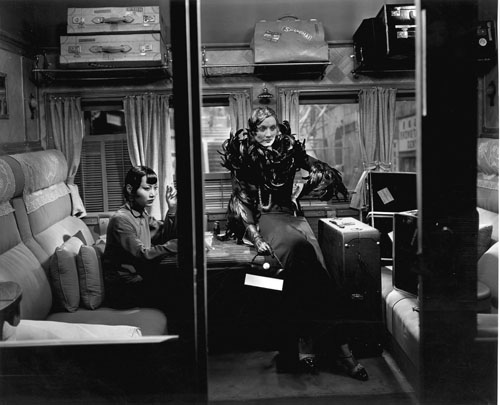|

|
 |
|
Last Updated: Feb 6, 2017 - 2:32:04 PM |
Berlinale Retrospective 2014: “The Aesthetics of Shadow. Lighting Styles 1915–1950”
By 64th Berlin International Film Festival
Nov 7, 2013 - 2:45:59 PM
|
Email this article
Mobile friendly page
|

Anna May Wong and Marlene Dietrich in Shanghai Express by Josef von Sternberg (USA 1932),
Source: Deutsche Kinemathek - Marlene Dietrich Collection Berlin
|
BERLIN, Germany - The Retrospective of the 64th Berlin International Film Festival will focus on light in film. Audiences will have an opportunity to discover lighting styles from specific genres and decades of film history in Japan, the USA and Europe.
“We admire films such as Akira Kurosawa’s Rashomon, but for the most part we don’t know the names of the cameramen and lighting technicians who, in a team with the director, create these superb worlds of light and shadow for us. In 2014 the Retrospective will illuminate these works,” comments Berlinale Director Dieter Kosslick. “For the second time, the Deutsche Kinemathek is curating the Berlinale Retrospective with The Museum of Modern Art. We are delighted that the films will also be shown in New York.”
Influenced by expressionism of the 1920s as well as by classic Hollywood lighting and Japanese architecture, the use of expressive lighting began to evolve at this time in Japan. It also sparked a theoretical debate on how to deal with shadows creatively.
In Japan people were fascinated by the aesthetics of director F.W. Murnau and greatly appreciated Josef von Sternberg’s magical world of shadows in The Docks of New York (USA 1928) and Shanghai Express (USA 1932). Henry Kotani, a Japanese cameraman who lived in the USA, was invited by Shochiku studio to modernize filmmaking with lighting effects and reflectors. Over the course of the next years, highly contrasting styles and effect lighting came into use in Japan, the USA and Europe. These techniques replaced the employment of natural sunlight in glass-house studios and uniform illumination.
Actor Douglas Fairbanks Sr., who decisively shaped American swashbuckler films, is a huge star in Japan. Also in the jidaigeki film Yukinojo henge (The Revenge of Yukinojo, Japan 1935/1952), flashing swords glitter in the black of night. Leading man Kazuo Hasegawa, who was also known as Chojiro Hayashi, became the biggest Japanese film star, also because of the sophisticated lighting concepts created for his face.
The mutual influence of other genres can be observed as well. Japanese and American war films presented heroic acts carried out by soldiers and troops for their countries. Here a shift towards realism can be discerned in the use of footage and locations from real war events. This trend is also reflected in classics such as John Ford’s The Grapes of Wrath (USA 1940), Orson Welles’ Citizen Kane (USA 1941) and Jules Dassin’s The Naked City (USA 1948), all of which explore the boundaries between reality and fiction.
The point of departure for the Retrospective was a publication by Daisuke Miyao: “The Aesthetics of Shadow. Lighting and Japanese Cinema” (2013). “Daisuke Miyao’s fascinating insights into the art of lighting, and thus into an area of Japanese film history that has hardly been studied, impressed us so greatly that we are curating our film programme in close cooperation with him,” states Rainer Rother, Head of the Retrospective and Artistic Director of the Deutsche Kinemathek. We are also indebted to Miyao’s suggestions for several German premieres of Japanese films, such as the samurai musical Oshidori utagassen (Singing Lovebirds, dir. Masahiro Makino, Japan 1939) – a film that has attained cult status in Japan.
The Retrospective will include some 40 silent and sound films. They focus on lighting styles for such diverse genres as the street film, jidaigeki and the war film; for stars, such as Marlene Dietrich, Greta Garbo, Kazuo Hasegawa and Sessue Hayakawa; and for other interesting themes. Among the highlights of the Retrospective will be recent restorations, including Gerhard Lamprecht’s Unter der Laterne. Trink, trink, Brüderlein, trink (Under the Lantern, Germany 1928), Fred Niblo’s The Mark of Zorro (USA 1920) and Allan Dwan’s The Iron Mask (USA 1929). As with all the silent films in the programme, these films will be accompanied by music performed live by renowned international artists.
The point of departure for the Retrospective were considerations resulting from research on Japanese film conducted by Daisuke Miyao, Associate Professor at the University of Oregon. Based on this, the concept was developed by Charles Silver, Rajendra Roy (Museum of Modern Art, New York), Rainer Rother and Connie Betz (Deutsche Kinemathek, Berlin).
A book in German, entitled “Ästhetik der Schatten. Filmisches Licht 1915–1950”, will be published for the Retrospective. In it, Daisuke Miyao, Kevin Brownlow, Karl Prümm and other authors address aesthetic and technical developments of lighting styles in Japan, Germany and the USA.
The film programme of the Retrospective will be supplemented by events put on by the Deutsche Kinemathek at the Filmhaus on Potsdamer Platz. Thanks to the cooperation with The Museum of Modern Art, the film series will also be shown in New York in January and April 2014.

© Copyright 2013 by thebahamasweekly.com
Top of Page
|
|
 |

|
